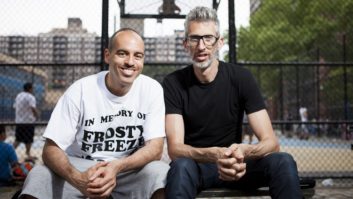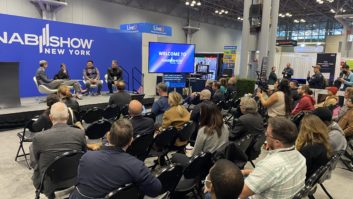
As our managers and company ownership look for ways to improve efficiencies, we may find ourselves looking toward cost reductions. But turning the power down on the transmitter or reducing the frequency of the tower strobe are frowned upon.
Energy efficiency is the theme of papers on Thursday April 15 at the NAB Show, “Green Technologies for Broadcasters,” chaired by Dom Bordonaro of Cox Radio. While some are not specific to radio, you will find that green is green. TV stations and film studios utilize a lot of gear similar to radio; heat load, power distribution and economics are as critical to them as they are to us. And if your station is breaking down the barriers between “just radio” and a full-service provider (including web video), most of this does apply.
The morning begins with “Sustainable Facilities and LEED Certification: A Broadcaster’s Guide” by Antonio Argibay from Meridian Design Associates.
The Leadership in Energy and Environmental Design rating system was developed by the U.S. Green Building Council. Such certifications are becoming mandatory or affecting regulations in some states and municipalities, and are therefore increasingly important in the design of broadcast facilities.

LEED categories, from the presentation by Antonio Argibay. His paper is an introduction to the LEED Certification process including how to meet the emerging regulatory landscape under which future facilities are built and existing ones upgraded.
Discussion of green technologies continue every half hour throughout the morning. These include one specific to what occurred at a DTV station, the design for a new film studio in Massachusetts, facility design improvements, improved lighting and alternative power for broadcasters.
A discussion of note is called “Hollywood East: Home of Sustainable Production.” The presenter, Stephen Newbold, an architect with Gensler, says that though radio is a vocal art, audiences are expecting more services, including visual, from radio broadcasters.
Newbold suggested these simple planning items for “green radio facilities”:
- Do more digitally. Remove “hard copy” from the process; this lowers power/heat requirements, space needs and speeds workflow.
- Include comfortable work areas, ergonomics, day lighting, visible teams and more supportive “work communities” in your planning to enhance staff retention.
- Increase “social spaces” in facilities; this may seem counterproductive but actually can increase productivity, enhance company culture and strengthen your brand.
- Limit isolation spaces to tasks that absolutely need them. This reduces operating expenses and lowers new construction costs.
- In 24/7 projects, pay special attention to amenities, services, parking, security and any non-core functions.
- Seriously address all equipment energy usage; great savings may be found in both ongoing operation and initial capital expenditures.
- Don’t perfect a facility for today’s needs and inadvertently exclude tomorrow’s.
- Build consensus before you build anything. Spend the time, money and energy in thorough planning. This falls under “those who fail to plan, plan to fail.”
Peter Bloomfield of Bloomfield & Associates will explore “Best Practices for the Design of Facilities: How Better Design, Better Acoustics and New Media Impact the Cost of Operations.”
More stations are adding streaming media, video content, webcasting and other new services. When architects are required not only to design for “sublime” spaces but to accommodate this increased technology and energy efficiency, what is the impact on design and operational cost?
Another morning discussion is about lighting. Though we in radio may not place emphasis on this, we can appreciate the impact of poor lighting on work performance (think of the movie “Joe Versus the Volcano” with Tom Hanks). We look at the impact on personal health and attitude, plus the cost benefit of being energy efficient — even of considering color temperature. As a radio broadcaster, this may be a new phrase to you, but color temperature of lights is important when you are considering the addition of video. Your talent may look green on Sunday mornings but you want them looking healthy for your future video endeavors.
The presentation is “HD Quality Energy Efficient, Low Heat Broadcast Lighting.”
And the morning concludes with Joe Talbot of Citadel’s KGO(AM)/KSFO(AM) in San Francisco, who talks about “Alternative Power Options for Broadcasters.”
A handful of stations have been able to “swipe power from nature” over the years. KFMU(FM) in Steamboat Springs, Colo., pulls about 3 kW from solar, which is enough to cover about 90 percent of their transmitter usage. WNHS(LP) in Newcomerstown, Ohio, may be pulling power from both solar and wind as their school district takes advantage of grants to install this green energy.
KGO needed about 20 kW of power for its transmitter site. Find out at this discussion how they did it and what your station might be able to do.











